Muur van Geraardsbergen: cycling's iconic places
The Muur van Geraardsbergen is one of the most famous climbs, having been used in the Three Days of De Panne, Tour of Flanders, Omloop Het Nieuwsblad and Eneco Tour
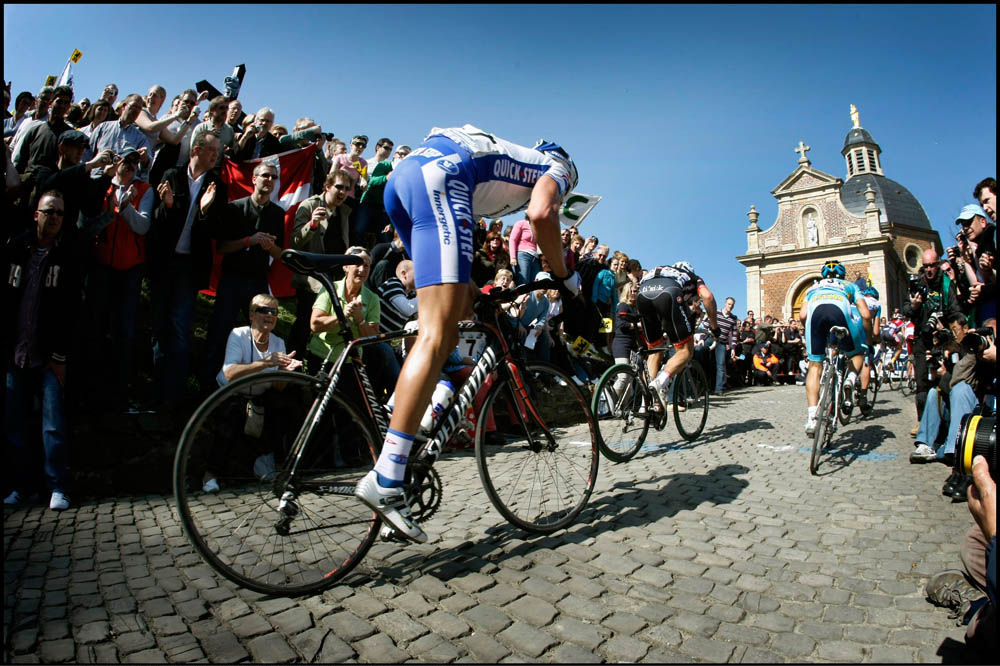
Tackling the Muur van Geraardsbergen during the 2009 Tour of Flanders
“The Muur is a rendezvous with your character,” Eddy Planckaert, 1988 Tour of Flanders winner
Every year, on the first Sunday in April, the 92 metres of the Muur van Geraardsbergen separate one man from history. Ninety-two metres, that’s all the height that the second last climb in the Tour of Flanders gains. Ninety-two metres that selects a winner of the most charismatic of bike races in front of the sport’s most fanatical fans.
Wielervolk they call them. The bike fans of Flanders. They love the sport of cycling, warts and all. Some love it to distraction, and to join them on the Muur is to worship inside their cathedral. The atmosphere builds for hours as they wait, like electricity building before a storm. When the first riders thunder past the fans are redlining with hysteria.
The lightning flash of colour passes so quickly and the Muur breathes again, relaxing into 364-day torpor as just another quiet road over a hill. Sanity is restored. Fans, who moments before were baying like hounds become fathers and mothers again, sons and daughters. The moment has passed, until next year.
>>> Tour of Flanders: Latest news and information
Muur means wall in Flemish and the words ‘the Wall shall choose the winner’ have passed into Flemish folklore, even if they aren’t literally true. Sometimes one man has forged ahead on the Muur and won, while just as often a group force their way clear of the rest and the winner of the Tour of Flanders comes from that group. Whichever, the fact that the Muur is at the end of a series of strength sapping cobbled climbs, its closeness to the finish and the sheer toughness and uncompromising nature of it as a cycling challenge make it the most iconic climb of this iconic race.
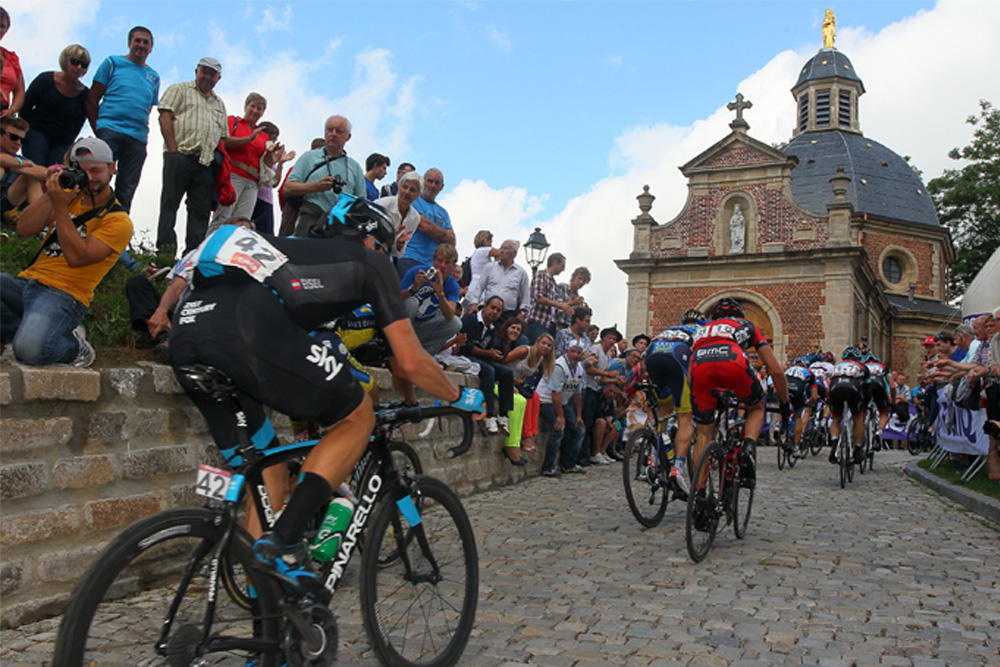
Columbia directeur sportif Allan Peiper, who now lives in Geraardsbergen, has a long history with Flemish racing, and with the Tour of Flanders. He sums up the Muur best when he says, “On a number of occasions in Flanders I was strong enough to make the front group at the bottom of the Muur, but only once was I strong enough to still be there at the top.”
Get The Leadout Newsletter
The latest race content, interviews, features, reviews and expert buying guides, direct to your inbox!
Real Classic
Other races use the Muur, but it is most closely identified with the Tour of Flanders. The race is a true Classic, a long haul over tough terrain that gradually erodes the frontrunners until only the strong remain. Then comes the Muur. At the bottom a select group ride in hope. But this is the severest test they have met all day, and one by one they slip out of contention, victims of the Muur and victims of vicious attacks from the men who are the real contenders.
The race starts with a relatively short and flat run from Bruges to the Belgian coast, where the wearing down process begins as the riders fan out across the wide flat roads in response to the cutting wind blowing in off the North Sea. This is the unseen phase of the race, the one that’s all graft and no glory, as teams fight to keep their favourites safe along the coast and inland towards the ridge of hills that makes up the Flemish Ardennes.
The ridge isn’t high, the tops barely scrape though the 100-metre contour, but the hills on its northern side are the jagged teeth of the Tour of Flanders. Up one, along the ridge, down and up another; the race rips itself apart on the ridge every year. Climb follows climb until there is a lull before the Muur. Here the race pauses, poised, riders and fans draw breath and hope. The Muur will decide, the winner will come from the first few over the top.
It hasn’t always been so. The Ronde van Vlaanderen, as the Flemish call it, began in 1913 and its first editions were long circuits on bad roads. Only as the race got older did it venture into the Flemish Ardennes, and when it did the Muur was just another climb. It was tried out in 1950 and stayed for three years. But then the race switched to using the Kloosterstraat ascent. It climbs the same ridge in Geraardsbergen, but slightly to the north. The Muur finally returned in 1970, and now a Tour of Flanders without the Muur would be like chips without mayonnaise.
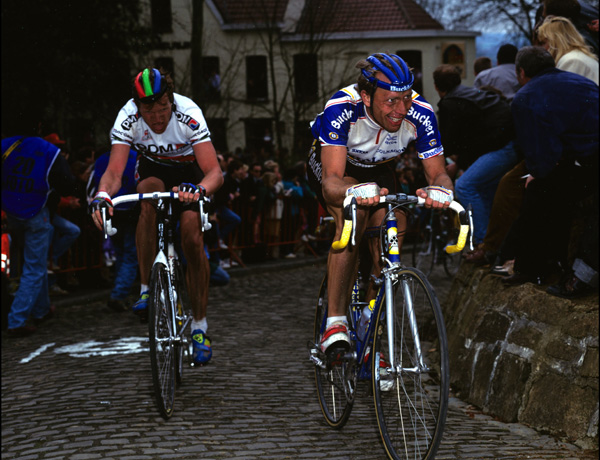
JELLE NIJDAM IN THE TOUR OF FLANDERS
“The Tour of Flanders is not a subtle race,” says the 1988 winner Eddy Planckaert. “You have to ride near the front all day; fight with your elbows, shoulders and even sometimes with your hands to be in a good place for the climbs. Then you must go hard on the climb and keep it going over the top because the really strong riders attack there. And you have to keep doing that time after time until the end. The Ronde takes character and strength but not too much thought.”
Which way?
The Tour of Flanders road book says that the Muur starts on Oudebergstraat and is 475 metres long, but in reality this is half way up. It is the crux of the climb, where the hostilities on race day take place. To go earlier on the Muur would be folly for a racer, but the full Muur can only be experienced from the very bottom of the climb.
You’ve seen it on TV. The riders climb a humped bridge over railway lines. It looks temporary but has been there for as long as locals can remember. A short descent and the green bridge over the river Dender.
And then it starts; Brugstraat, a tiled pedestrian free-for-all most days of the year.
Slowly the gradient increases. Flick left and right into the market place. The Gothic town hall is on the left and St Bartholomeus Church on the right. The cobbled road climbs past bars and cafes, many serving Geraardsbergen’s contribution to the cuisine of Flanders, the Mattentart, a pie made with fermented milk.
Geraardsbergen is old, part of the Land Van Aalst, which pre-dates the ancient Kingdom of Flanders. In the 11th century it became part of Flanders and grew to become a fortified city centred on St Adrien’s abbey. This was so important that the town became known as Adrienopolis.
A sharp left turns onto Vesten, a two-lane cobbled highway at the top end of the town’s commercial area. The gradient begins to bite on this long straight stretch of the climb. A sharp right onto Oudebergstraat (Old Hill Street) and the real Muur begins. The road sweeps left, right and left again, really beginning to pull on the legs as it steepens all the way.
Past a statue, an impression in bronze of the bike fans of Flanders. Past a gable end exhibition of black and white photographs taken by Steven Van Vletteren as part of his dedication to the fans. This is their place. Further up the climb a stone bears a poem by a Flemish writer about Eddy Merckx. Another, attached to the cafe near the top, is called Flandriens. Flandrien being a mark of respect the Flemish pay to those who show the characteristics they hold in high esteem.
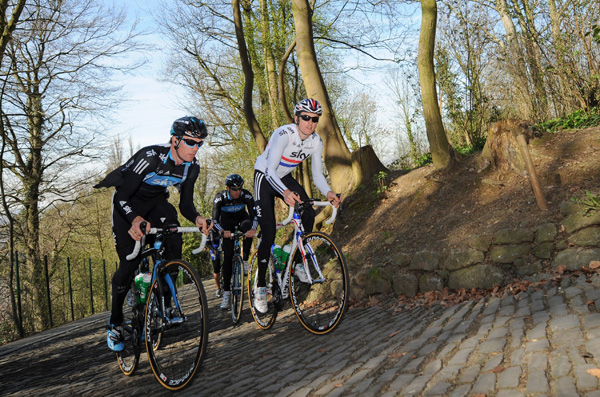
TEAM SKY CLIMBS THE MUUR VAN GERAARDSBERGEN
The Muur as a sporting challenge is tolerable until a sharp right where the houses give way to trees. No one builds here, the ground is too steep. A bollard in the middle of the road prevents cars from going any further. They take it away on race day but the following vehicles still aren’t allowed up here.
This is two-wheeled terrain, the essence of the Muur. No buildings, no pavement, just a whaleback of pave going straight upwards. The cobbles are bad but not as bad as they were. In 2004 the town council laid new cobblestones at a cost of one and a quarter million euros, although that was offset by selling off the old ones at 2.5 euros each.
The road is unmerciful, and it was treacherous in bad conditions before it was re-laid. “There used to be a line to ride,” says Eddy Planckaert, “a line worn by the tyres and by people walking up there. It was a line of smoother cobbles, you could see it and if you followed it the Muur was easier. Not much, but easier. But if it rained the line was no good, it was too worn, too slick. You had to ride at the edge where the roughness gave some grip.”
That line has gone and with it, the real experts say, a bit of the Muur’s character. The cobbles don’t camber as much from the road centre now, and they are much more even. In the past potholes and subsidence lay in wait for the unwary. “The line used the camber best, which is why there were falls when it was wet. If you went off line and couldn’t find a good place on the edge you had little control over you bike,” says Planckaert.
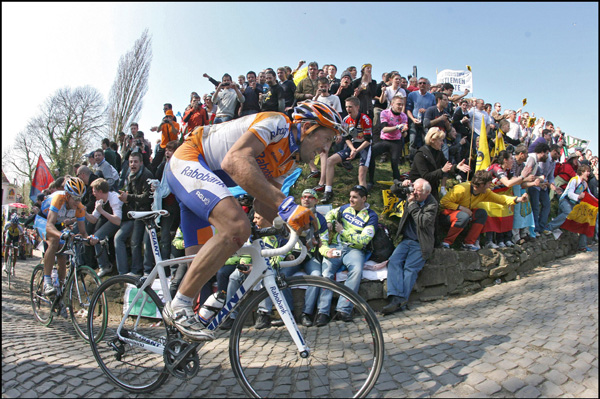
Now the Muur is a little fairer, but it is still incredibly tough and selective. The hardest part, a pitch of 19.8 per cent, is quite near the top. Then comes a sharp left with a sheer earth bank on its inside. The classic Muur photos are taken here. The trees cast an unusual light, flashes pick out the riders eyes, and their eyes tell their Flanders story. Moving forward or slipping back, burning with thoughts of victory or growing dim with the realisation of defeat.
Then the gradient eases. There is a sudden moment of flat before the last ramp. Until 1981 this was it, this was the top of the Muur, but now the route loops around a chapel standing on what looks like a man made mound at the top; the Kapelmuur. This is the last gasp. There is still an opportunity here for the strong to turn the screw still further. Just enough for the weak to say goodbye altogether.
The best riders lever their way over this final obstacle then down the other side, turn left onto Dreipikkel and launch themselves down Oude Steenweg and towards the Bosberg, the last climb of the Tour of Flanders. The rest manage as best they can. Some ride desperately, still in hope. For others the light has gone, but at least they will finish. “It’s not far,” the good natured in the crowd shout. It’s never far, according to the fans.
Six men of the Muur
Fiorenzo Magni
Four men have won the Tour of Flanders three times; Achille Buysse, Fiorenzo Magni, Eric Leman and Johan Museeuw, but only the Italian, Magni won it three times in succession. Triple winners get called Lions of Flanders after the rampant black lion with red claws on the yellow regional flag. In Italy they call Magni, who is 87 but still very active in cycling, il Leone delle Fiandre.
His Flanders victories came in 1949, 1950 and 1951 and he was the first winner to ride over the Muur van Geraardsbergen on its introduction in 1950. Talking recently about his success Magni said, “All I heard about the Tour of Flanders was bad roads, worse than Paris-Roubaix even, and bad weather, but I thought the race would suit me. I went well in extreme weather, hot or cold. I prepared for it and even used wooden wheel rims because they had some give and didn’t break as easily as the metal ones in those days.”
Eric Leman
Another three-time winner, this fearsome sprinter from West Flanders won in 1970, the year the Muur was reinstated, then won again in 1972 and ’73. He might have won in 1971, but it was a terrible year for him - his wife was killed in a car crash just one week before the race.
Leman was unique, a sprinter who could win three stages in a Tour de France, as he did in 1971, but who was so durable that he had 17 top ten Flanders performances in his career. He was incredibly difficult to beat in his favourite race. Men like Eddy Merckx, Frans Verbeek and Roger De Vlaeminck all tried, but it was so difficult to shake him off.
Anyone who took Leman to a sprint lost it. It’s rumoured that in 1970 his co-escapees Merckx and Walter Godefroot made a pact to attack him in turn after the Muur. It didn’t work, he handled everything they threw at him and beat them both in the sprint. At 27 Leman was the youngest ever three times winner.
Eddy Merckx
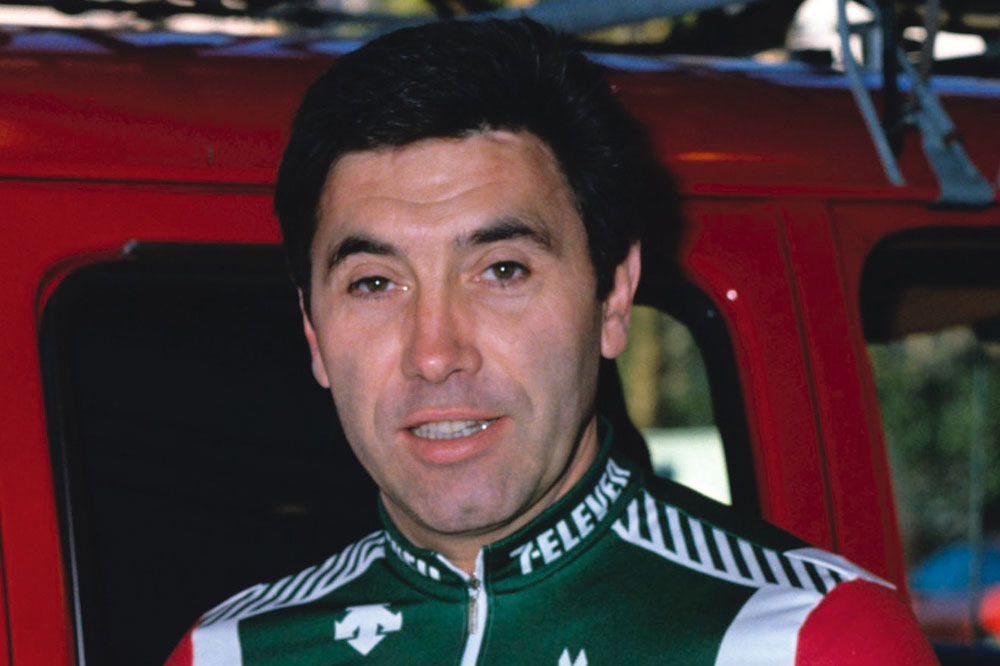
It’s hard to pick a Merckx win as being out of the ordinary because he was out of the ordinary almost every day. In the 1975 Tour of Flanders he attacked on the Kwaremont with 100 kilometres to go, simply because he could. Only one man could follow, the super tough Frans Verbeek, and he couldn’t contribute much. Up and down the Flemish Ardennes they went, Verbeek helping where he could but for the most time Merckx set a horrible, infernal, metronomic pace. For a long time their lead was a minute, but then the elastic snapped and the chasers fell back to two, then three, then more.
It was the first year of the Muur-Bosberg combination. From 1970 the Muur had been the final climb. Merckx romped up its slopes increasing the pair‘s lead by another 30 seconds. Verbeek could do nothing by now and with five kilometres to go Merckx rode away on his own to win by 30 seconds from Verbeek.
The next man, Walter Planckaert, was five minutes behind. A few years ago Verbeek told us what it was like riding with Merckx that day; “I’m sure he could have dropped me earlier, and if he had he would have won by 10 minutes. But I think Merckx liked the way I raced, so he made sure that I took second. That way he could thumb his nose at the Flandria riders, which always pleased him,” he said.
Johan Museeuw
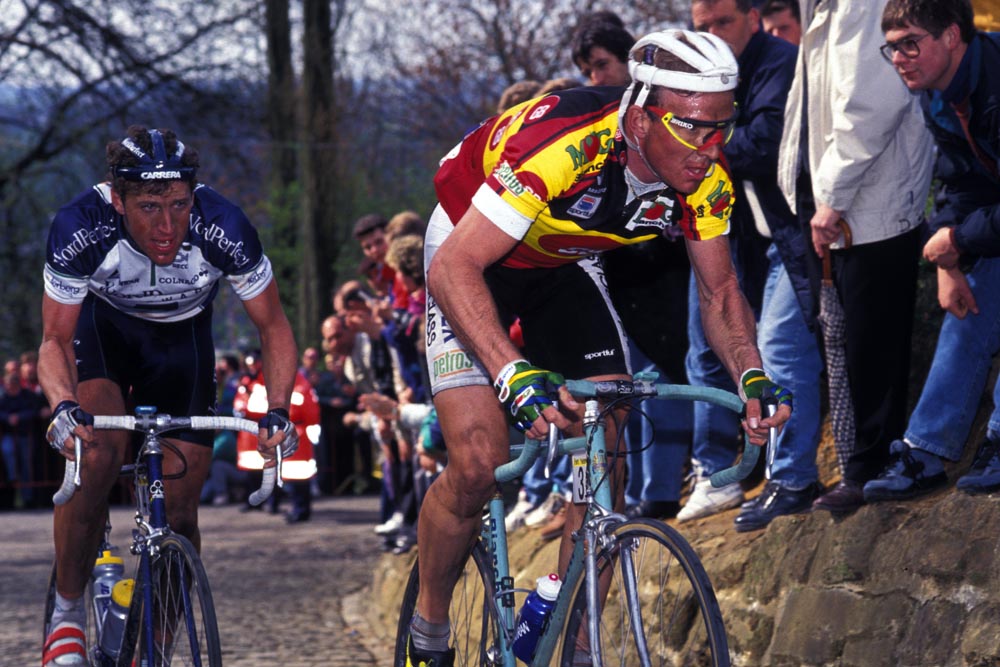
Doping erodes credibility like acid. Since Museeuw’s name was connected with a doping inquiry surrounding a veterinarian, Jose Landuyt, all his results are tainted, rightly or wrongly. All the work, all the dedication, all the guts and determination are clouded.
Of course Museeuw won’t see it like that. He lives in the bubble of Belgian cycling where he is still a hero. And that is a powerful drug itself. Maybe Museeuw was clean when he won three times, maybe they were the glorious performances that they looked Maybe not.
Peter Van Petegem
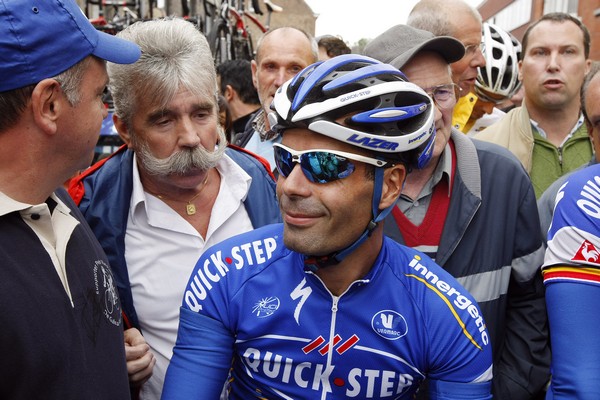
On the two occasions that Van Petegem won the Tour of Flanders, he did it by attacking on the Muurm and each time he beat the same rider into second place. Victory number one came in 1999 when Van Petegem used the Muur to escape with Johan Museeuw. The pair were caught by Frank Vandenbroucke and Museeuw weakened on the run in, allowing Van Petegem a sprint formality against Vandenbroucke. In 2003 Van Petegem attacked again with Vandenbroucke following, only to outsprint him again.
Van Petegem’s cycling life revolved around the Tour of Flanders and Paris-Roubaix. He rarely rode the mid-week race of the cobbled Classics, Ghent-Wevelgem. It was all for Flanders and Roubaix. He lives on the Flanders route and he puts his successes down to local knowledge. “I knew the route in every condition. That meant I could sometimes relax in what for others is a very nervous race and therefore save a lot of energy,” he says.
Fabian Cancellara
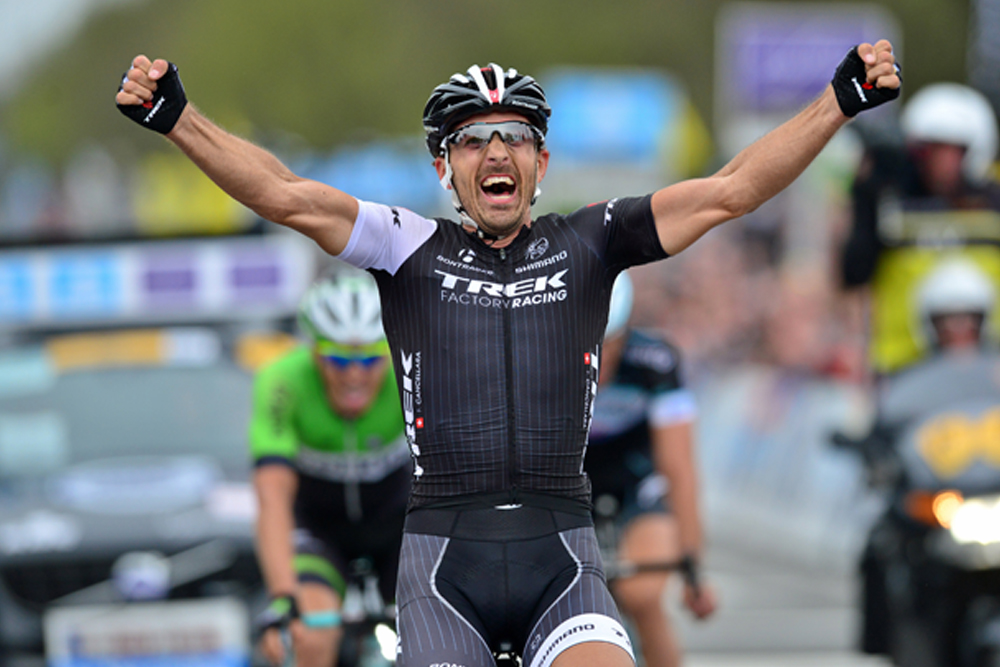
Fabian Cancellara’s attack over the final bends of the Muur in the 2010 Tour of Flanders was equal to anything that the climb has seen in its history. Cancellara had formed an extremely televisual two-up break with Tom Boonen – two national champions, one from Belgium, one from Switzerland – over the Molenberg. Cancellara’s problem: Boonen is a faster sprinter. But Cancellara either sensed weakness in his rival on the Muur, or sensed his own strength, and smoothly accelerated, while Boonen suddenly looked like he was riding through treacle.
By the top, Cancellara was out of sight, having opened a gap which surprised the helicopter TV cameraman, who panned from Boonen as he passed the summit, down the steep ramp off the Kapelmuur, along the flat road to the beginning of the descent. Cancellara had opened a gap of over 150 metres in that short, sharp attack. He went on to win again in 2013 and 2014.
Pro’s eye view
Tour of Flanders winner Eddy Planckaert shares his memories of the Muur
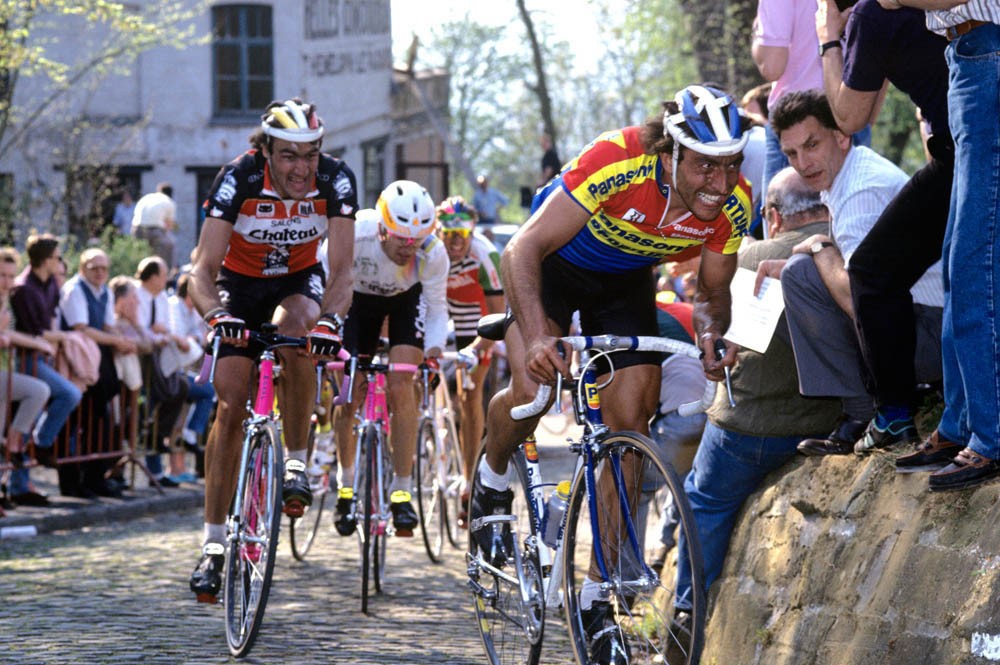
What is your big memory of the Muur?
The noise of the crowds is the impression left by the Muur. It is like riding through a tunnel of noise that you can almost touch. The fans on the Muur have a force together, willing you on. It means that the Muur hurts less than it should.
And when you won, what was your memory from that day?
Phil Anderson’s strength at the end. When we were together I knew I would beat him in a sprint, but so did he. The problem for me was getting to the sprint with him. He attacked so many times, going so hard, I had to dig very deep to hang on. The sprint was always going to be mine though. You can hardly see him in the photograph.
Is the Muur the hardest climb in the Tour of Flanders?
It’s hard, but the Koppenberg is harder. The first climb of the day is also very hard, no matter which one, because riders are fresh and the climb is a change of rhythm. You suffer there. The thing with the Muur is you cannot make a mistake or have a bad time because it is too close to the finish.
What happened on the Muur the day you won?
Anderson, Adrie Van der Poel and I took it together. Anderson mostly set the pace. Hard but steady because it was still too early to try on his own.
Was the Tour of Flanders the race you most wanted to win?
It was the one I grew up knowing I needed to win. I am from Flanders and for the people there it was the most important race. Also my brother Walter won it. The win that gave me most pleasure though was the Tour green jersey. My oldest brother, Willy won it in 1966 and Willy was my hero. When Willy won the green jersey he saved our family. My father had just died, I wasn’t yet 10, Walter was 18, and we were facing financial ruin. Willy came home and put a suitcase full of money on the table, and that saved us.
What advice would you give to a cyclist riding the Muur for the first time?
Pick a gear that you can ride sat down so you keep weight over your back wheel and don’t cut the corners, it’s steeper on the insides. Oh, and stop for a beer in that café at the top.

Thank you for reading 20 articles this month* Join now for unlimited access
Enjoy your first month for just £1 / $1 / €1
*Read 5 free articles per month without a subscription

Join now for unlimited access
Try first month for just £1 / $1 / €1
Edward Pickering is a writer and journalist, editor of Pro Cycling and previous deputy editor of Cycle Sport. As well as contributing to Cycling Weekly, he has also written for the likes of the New York Times. His book, The Race Against Time, saw him shortlisted for Best New Writer at the British Sports Book Awards. A self-confessed 'fair weather cyclist', Pickering also enjoys running.
-
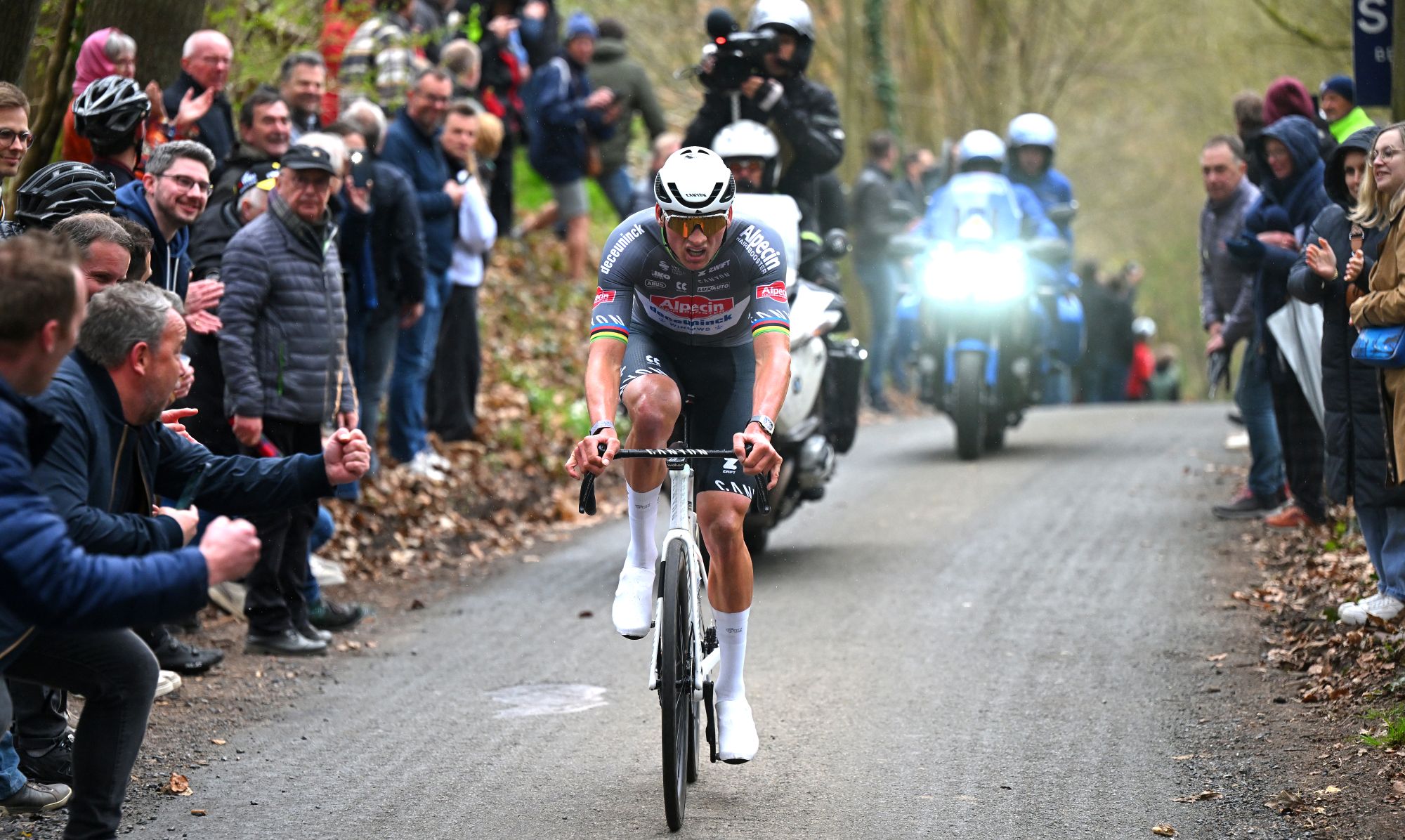 'I start every race to win' - Mathieu van der Poel fired up ahead of Paris-Roubaix showdown with Tadej Pogačar
'I start every race to win' - Mathieu van der Poel fired up ahead of Paris-Roubaix showdown with Tadej PogačarTwo-time winner says he has suffered with illness during spring Classics campaign
By Tom Thewlis Published
-
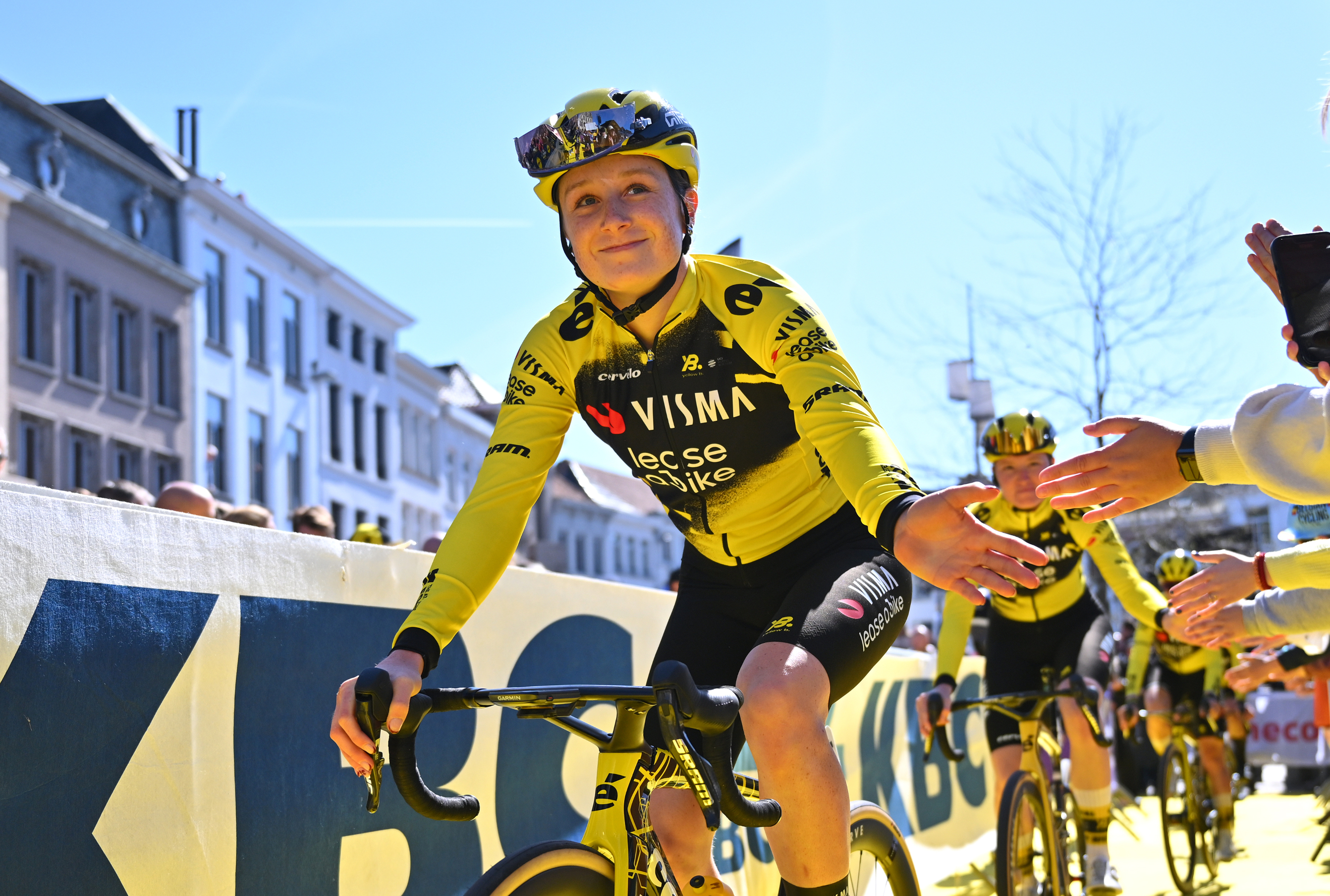 'It's really surreal that now I'm part of it' - 19-year-old Imogen Wolff set to go from spectator to racer at Paris-Roubaix
'It's really surreal that now I'm part of it' - 19-year-old Imogen Wolff set to go from spectator to racer at Paris-RoubaixBrit first came to see the 'Hell of the North' when she was six
By Tom Davidson Published
-
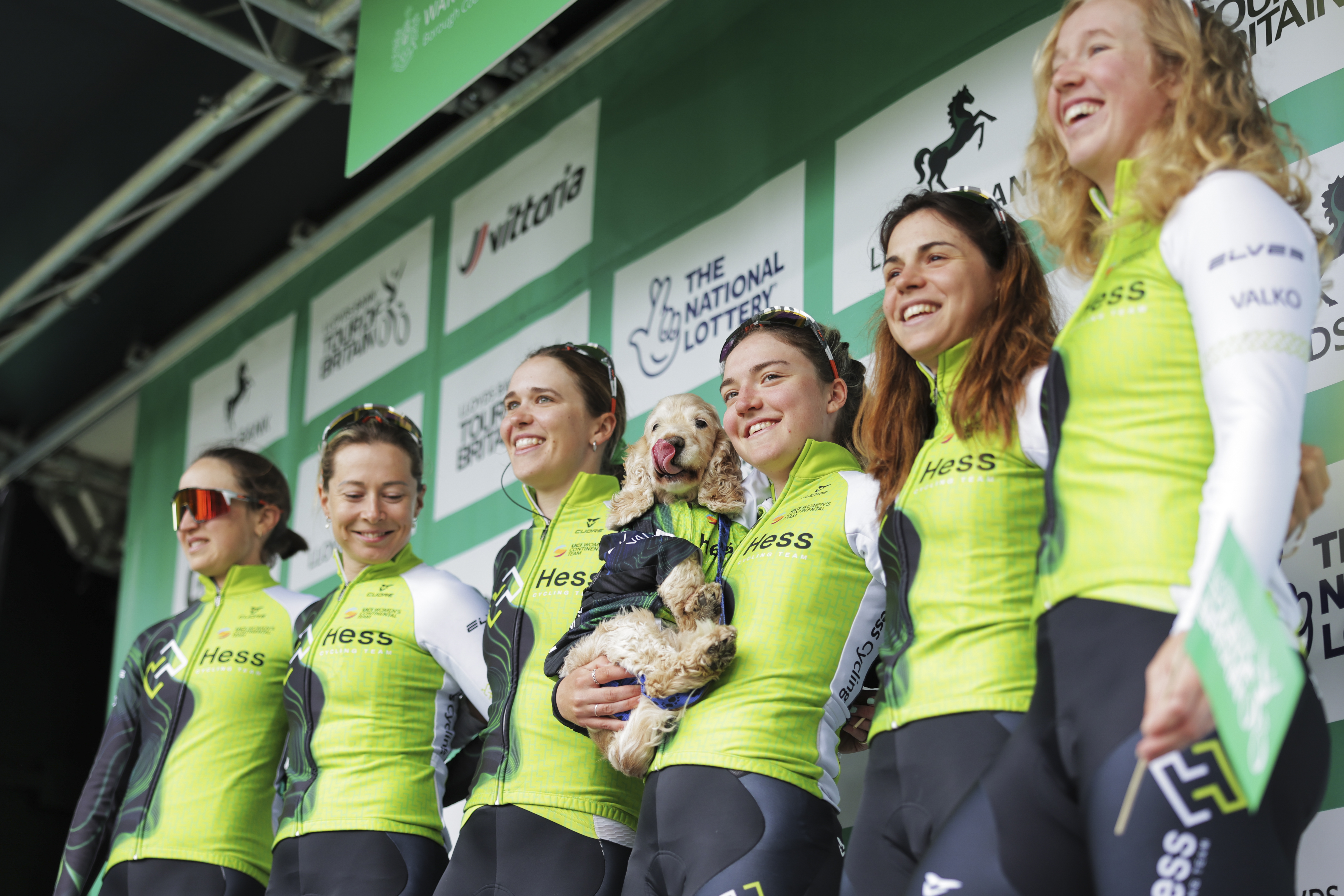 British team blocked from competing in key Spring Classics
British team blocked from competing in key Spring ClassicsHess Cycling not invited to Amstel Gold Race
By Tom Thewlis Published
-
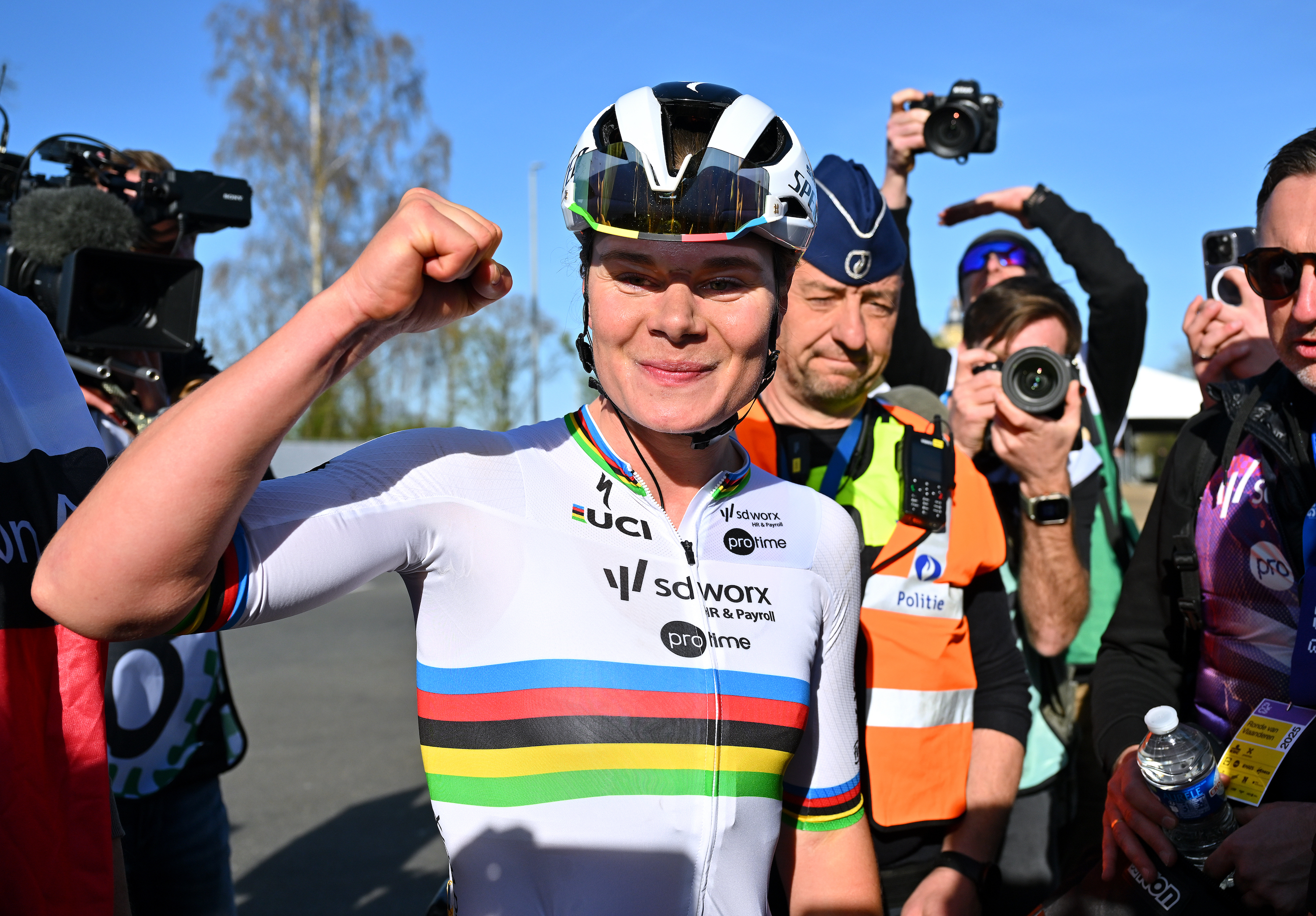 'Once we were four, I was really confident about winning' - Tenacious Lotte Kopecky hangs in at Tour of Flanders for victory
'Once we were four, I was really confident about winning' - Tenacious Lotte Kopecky hangs in at Tour of Flanders for victoryThe Belgian isn't interested in making history, but is just doing so accidentally
By Adam Becket Published
-
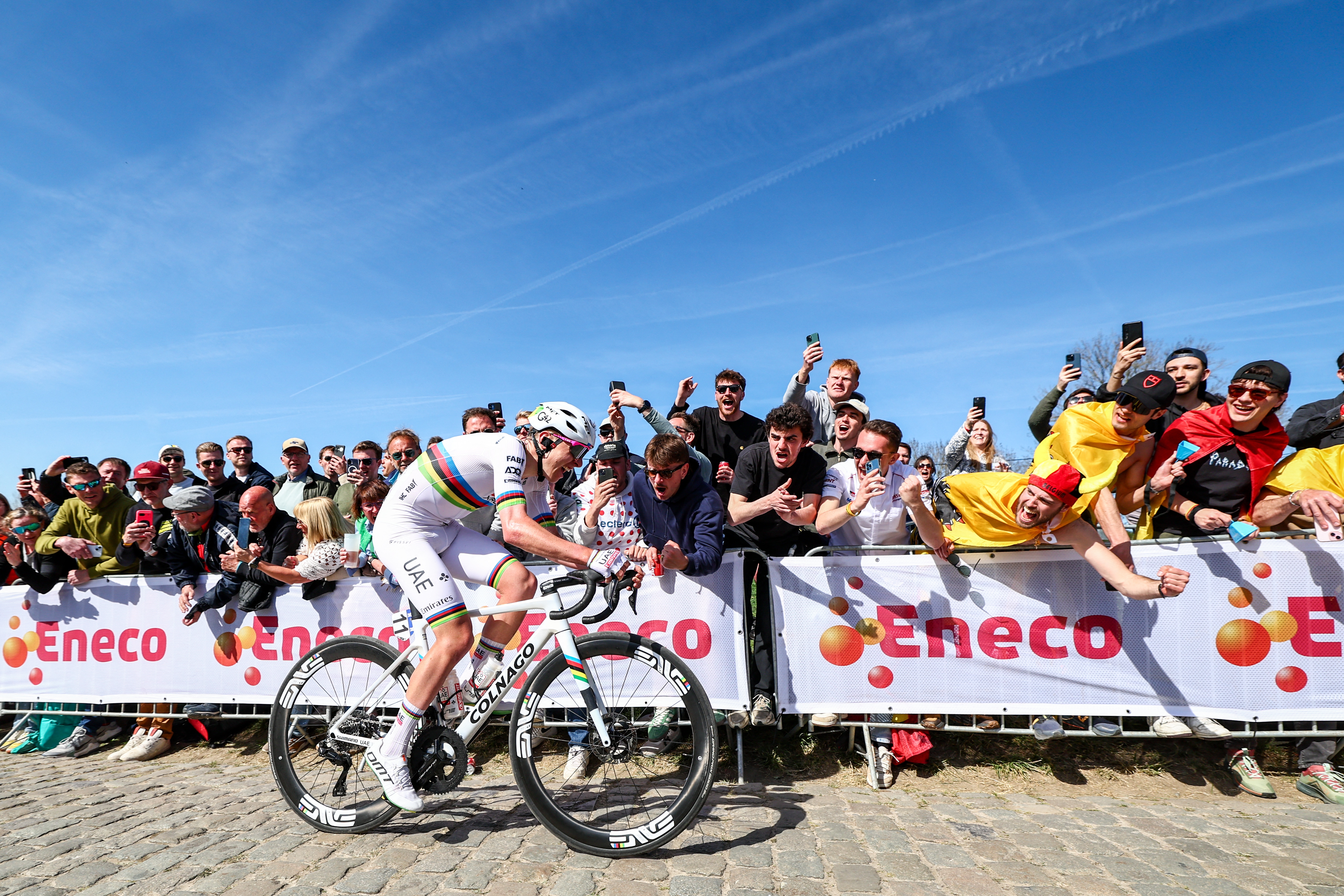 'It's scary to see how much better he is' - Tadej Pogačar conquers all at the Tour of Flanders
'It's scary to see how much better he is' - Tadej Pogačar conquers all at the Tour of FlandersThe world champion won by a minute after a decisive attack on the Oude Kwaremont
By Adam Becket Published
-
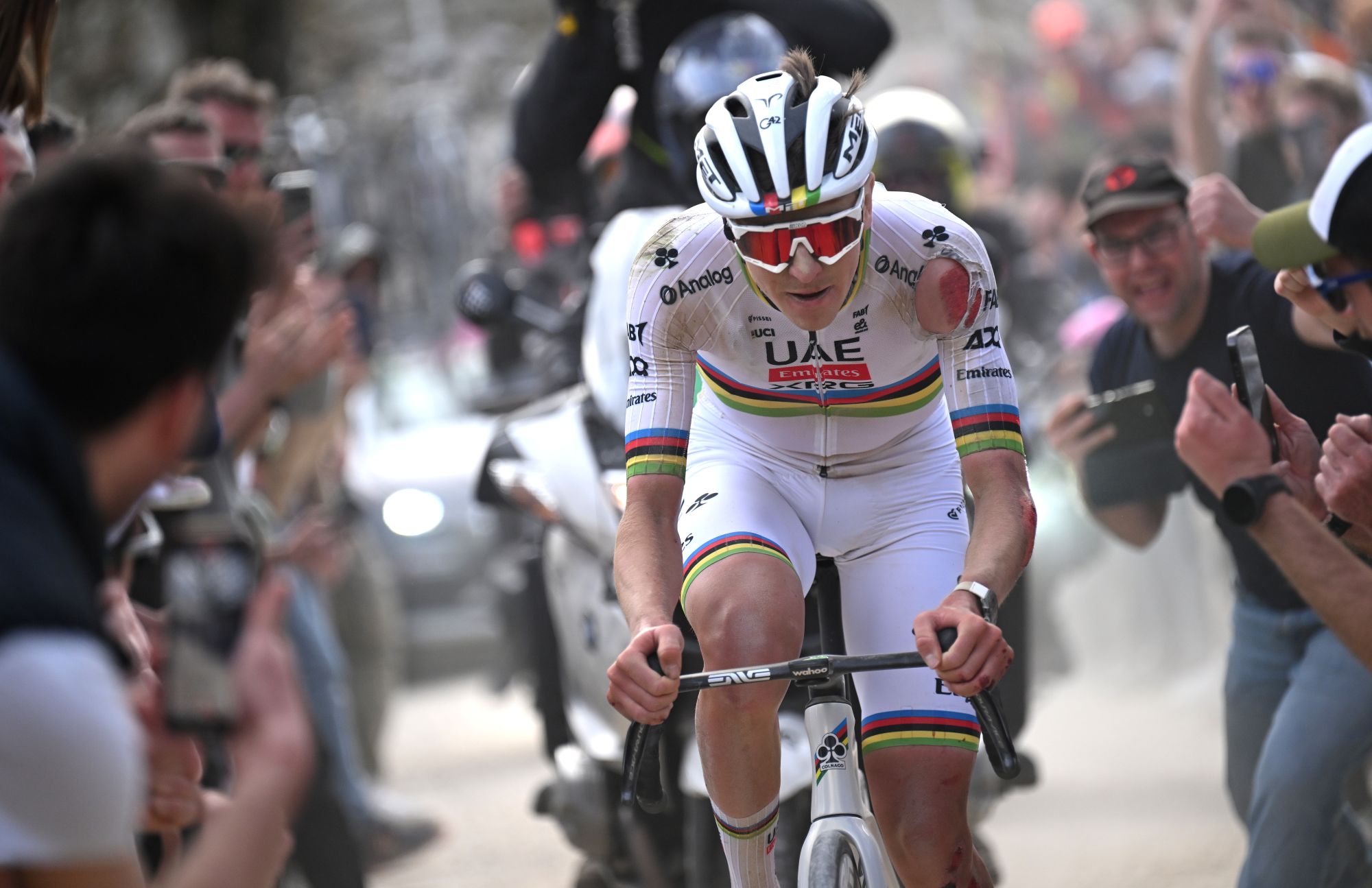 Tadej Pogačar must attack from range at the Tour of Flanders - taking Mathieu van der Poel to the line is not an option
Tadej Pogačar must attack from range at the Tour of Flanders - taking Mathieu van der Poel to the line is not an optionSlovenian must look to replicate his Oude Kwaremont attack from 2023 if he wants to guarantee being first across the line in Oudenaarde
By Tom Thewlis Published
-
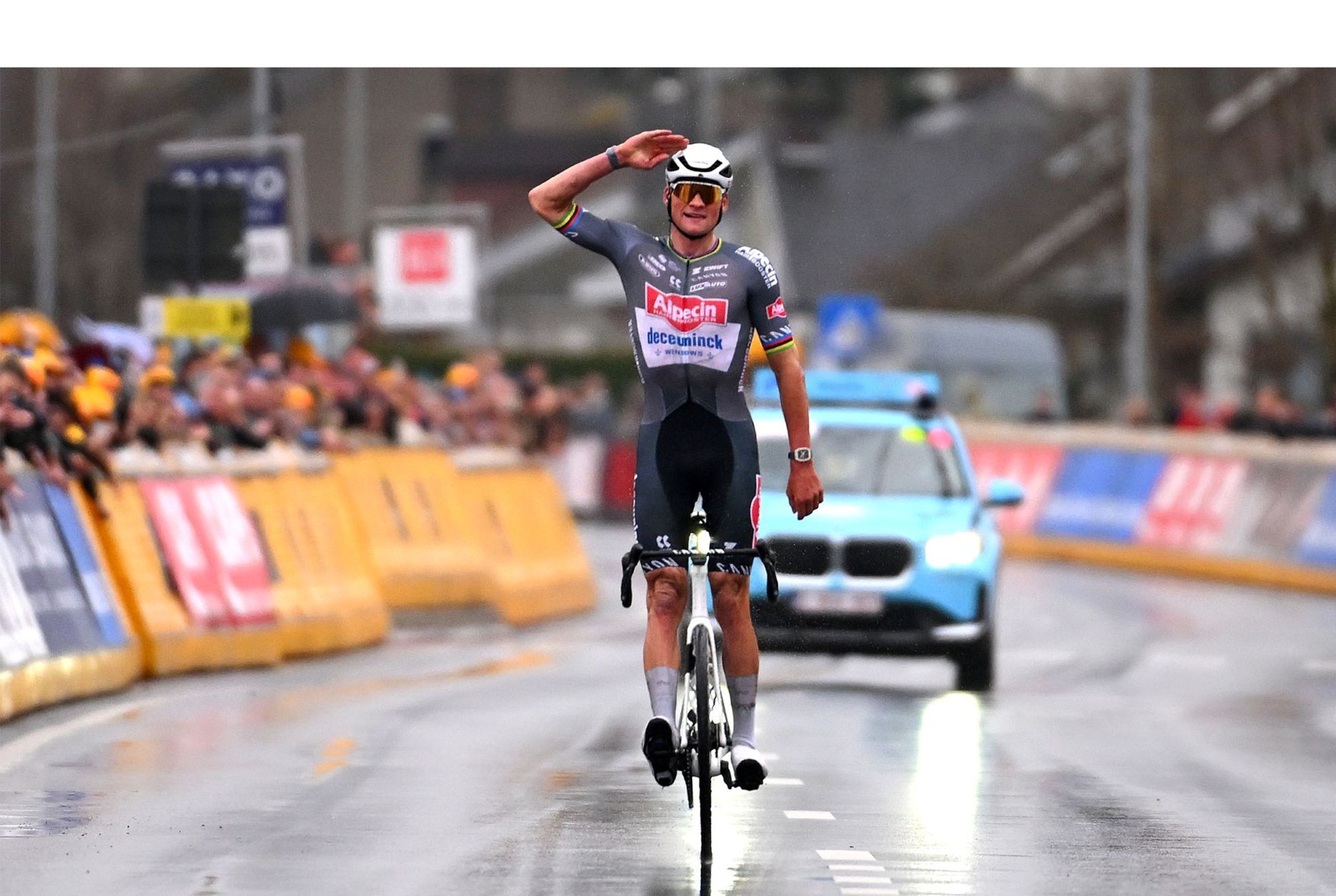 Mathieu van der Poel surges to E3 Saxo Classic victory after dropping Mads Pedersen on the Oude Kwaremont
Mathieu van der Poel surges to E3 Saxo Classic victory after dropping Mads Pedersen on the Oude KwaremontDutchman untouchable in West Flanders after distancing Pedersen and Filippo Ganna on decisive climb
By Tom Thewlis Published
-
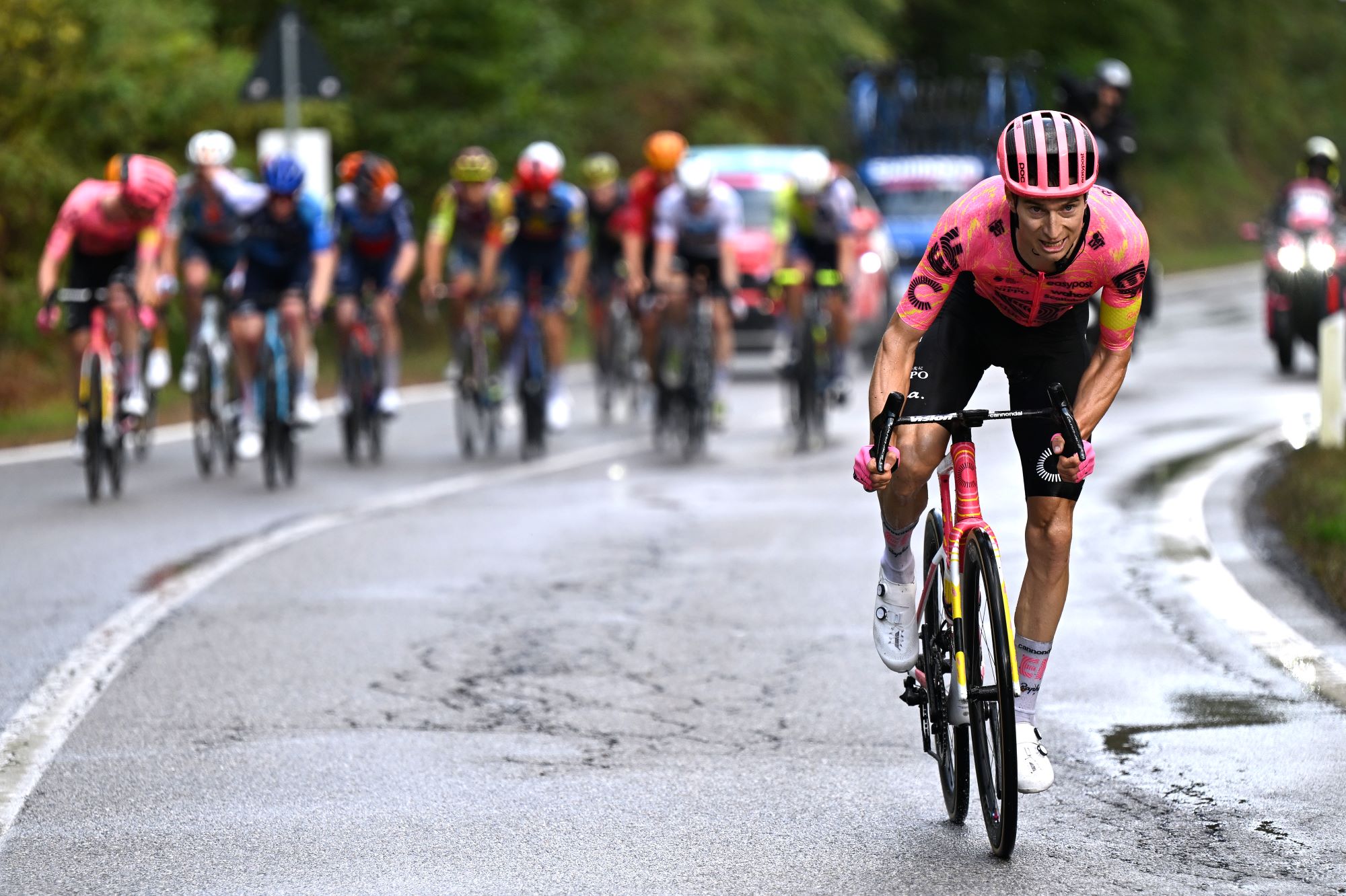 'Flanders is a race that demands a complete cyclist' - Neilson Powless aims for the Ronde in key month
'Flanders is a race that demands a complete cyclist' - Neilson Powless aims for the Ronde in key monthThe American is set to ride Paris-Nice before taking on the Tour of Flanders and the Ardennes Classics
By Tom Thewlis Published
-
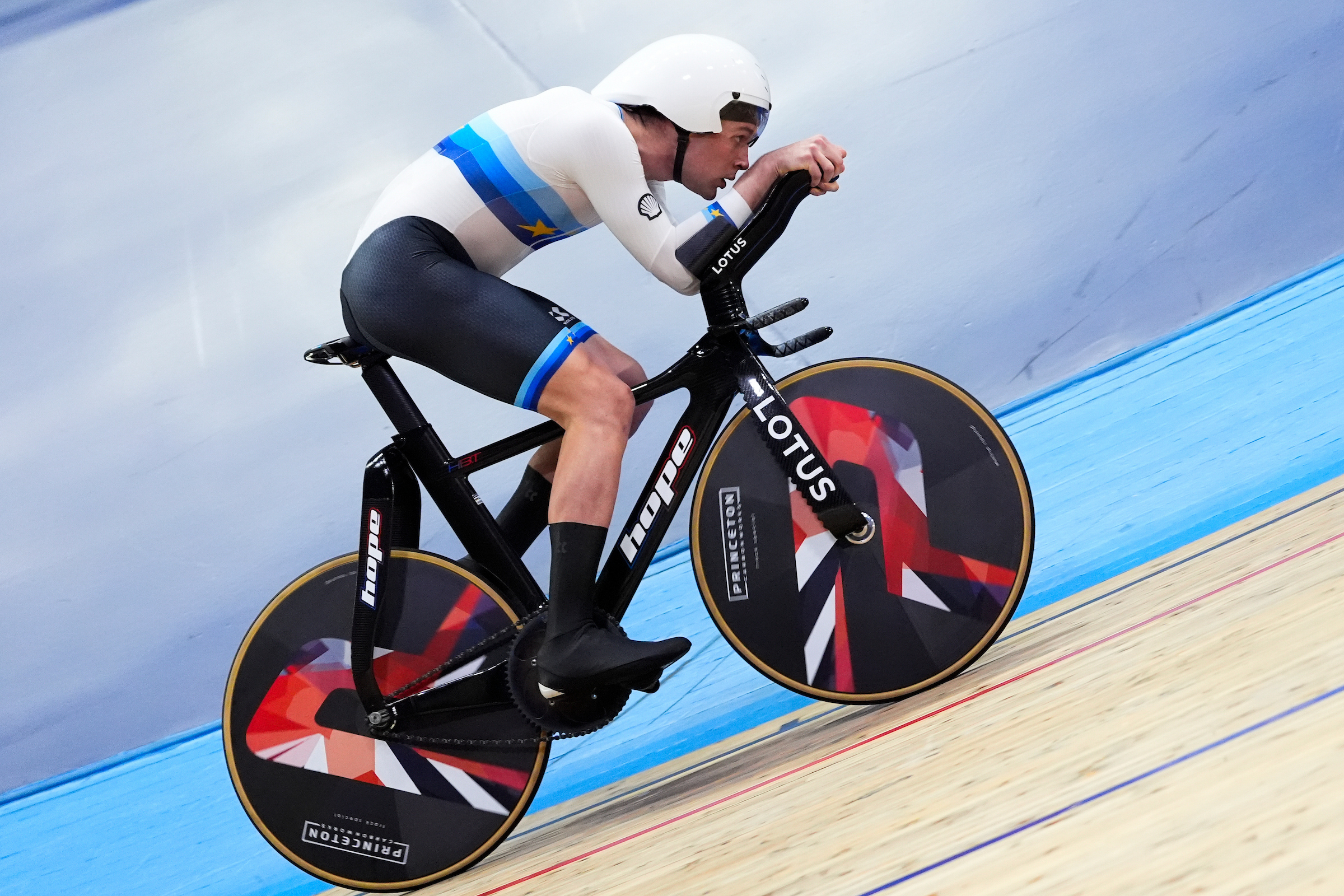 'Five or six WorldTour teams asked for my data' - Interest grows around world record breaker without a road team
'Five or six WorldTour teams asked for my data' - Interest grows around world record breaker without a road teamJosh Charlton says there's "definitely interest" in his signature
By Tom Davidson Published
-
 Men's WorldTour 2025: Everything you need to know about the teams
Men's WorldTour 2025: Everything you need to know about the teamsThe leaders, transfers and team ambitions set to shape the season ahead
By Adam Becket Published